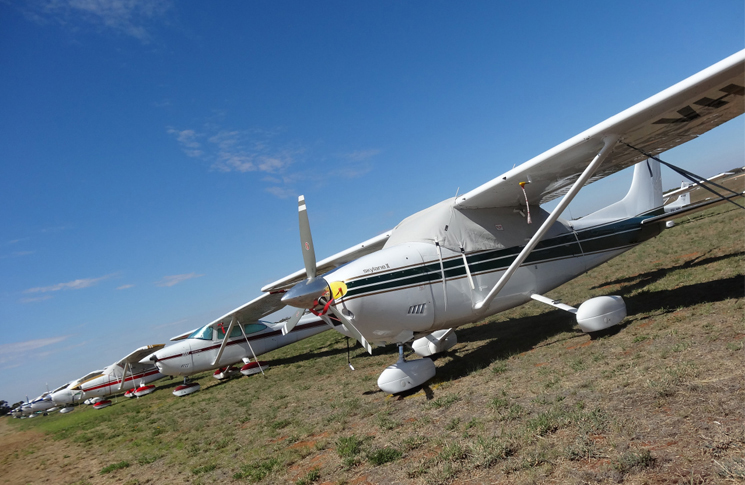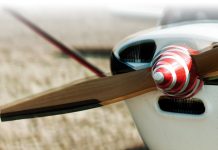If you’re a frustrated flyer, grounded by the social distancing requirements to keep everyone safe, there are still activities and study you can do to help maintain your aviation skills.
How about ‘virtual flying’, brushing up on GPS knowledge, studying weather charts or trying to really understand a maintenance release? These activities can help students and low-hours pilots utilise this downtime to improve their knowledge.
Catherine Fitzsimons, who runs WardAir in Bathurst, is not currently conducting flying lessons, but has come up with innovative ways to engage students.
‘There are plenty of things we can do to stay connected with aviation and help keep you current, prepare you for future flight reviews, ratings, endorsements and flight tests, not to mention helping you get ahead (or refreshed!) on aviation theory for your next exam,’ Fitzsimons says.
‘We’re running a number of tutored online workshops and virtual flying trips (maximum six per group) over the coming months. We’ll do any theory you need to pass CASA RPL/PPL/CPL exams but will also be offering an exciting range of virtual adventures and knowledge refreshers.’
These courses include:
- preparing for a flight review by brushing up on all the rules and regulations
- GPS knowledge
- NVFR knowledge: a head-start for those planning a night rating or preparing for a night flight review.
- PIFR knowledge: prepare for an instrument rating and pass the CASA PIFR exam.
- GAF/GPWT/flight notification: a refresh on weather forecasts and flight plans
- radio telephony: polish up radio calls for controlled and non-controlled airspace.
Courses will vary in length, but most will be delivered in multiples of two-hour blocks at times to suit the participants.
What is your flying school or aeroclub doing to support its members and help maintain their skills? Please let us know.
ASAs share their top tips
CASA Aviation Safety Advisor (ASA) Tim Penney says, ‘It is not our job to be flying instructors, but we can certainly remind pilots that if they may have forgotten some important topics over the years or perhaps not ever properly got their head around some aviation concepts from the start, now would be an opportune time to rectify that.’
Here are the tips from the expert CASA team:
Brush up on BOM forecasts
Pilots are encouraged to visit the Bureau of Meteorology’s ‘Knowledge Centre’ to freshen up their knowledge about the interpretation of Graphical Area Forecasts (GAF) in particular. Many pilots still have considerable difficulty with the interpretation of this relatively new forecast format or may have yet to really devote time and energy to understanding it. The knowledge centre has resources devoted to the interpretation of Terminal Area Forecasts (TAFs) and Grid Point Wind and Temperature forecasts.
The centre also contains guides for a variety of hazards in aviation such as thunderstorms, icing and turbulence. Information that many of us learnt in their training, often years ago, can very easily be forgotten, especially for pilots who flew infrequently, even before these restrictions came into force.
Review weight, balance and aircraft performance
Why not use this time to reacquaint yourself with vital operational knowledge surrounding the operation of your aircraft? Ask yourself ‘how well do I really know my aircraft?’ For example:
- Do you really know how to perform a weight and balance calculation, or have you become too comfortable just plugging numbers into an iPad app that does it all for you? Use this time to practise these calculations directly from the performance charts and from first principles.
- Do you know what a ‘moment arm’ is and how it impacts on the weight and balance of an aircraft?
- What happens to the aircraft’s centre of gravity as fuel is consumed?
- How does the fuel system in my aircraft really work?
- How does the electrical and/or hydraulic system function?
- Do I really know how to use the performance tables for cruise at various pressure altitudes?
Learn the finer points of maintenance releases
Pilots could also spend some time developing a knowledge of the maintenance release (MR) which is an important document consistently misunderstood by many and is an issue commonly seen during a ramp check. Few people set out to fraudulently deceive with the maintenance release, but there are still many pilots who don’t fully understand how to interpret the MR and how to fill this document out correctly. CASA has released two booklets that provide valuable information for the ongoing maintenance of aircraft, whether you are a pilot and/or an owner/operator.
- What does a maintenance release actually say about the airworthiness of an aircraft?
- Do you really know how to fill in times, certify for daily inspections or write up defects on an MR?
- What exactly are you, as a pilot, allowed to certify for?
- What is a service bulletin?
- What does ‘Maintenance permitted by a pilot under Schedule 8’ mean for me?
Find the Maintenance guide for owners and operators and Maintenance guide for pilots on the CASA website.
Get acquainted with Human Factors for Pilots and Engineers
This time is perfect for pilots and engineers to begin working their way through CASA’s Human Factors kits. The kits cover a broad range of topics and include a workbook with practical exercises, discussion areas and reference material. The corresponding videos contain interviews with a plethora of industry experts and practitioners. The kits are perfect as a self-paced course (or can perhaps be used by several people joining together online) to develop a greater awareness of how human factors impact on the safety of your day-to-day operations.
Visit the CASA website to get your copy (available in hard-copy and digital format).
You can also access the CASABriefing YouTube channel for lots of interesting and educational material.
Go flying indoors
Perhaps you are spending time on your home flight simulator, practising free flight in VFR or an instrument approach, which can be handy if you have a check coming up. The simulator keeps you in the flying mindset and enables you to practice things such as emergency procedures from the comfort of your home, so when this is all over, your skills haven’t deteriorated too much. There are also groups running virtual airlines so you can connect with likeminded pilots. And it doesn’t all have to be study—try something different, such as teaching yourself to fly a helicopter!
Chair flying
Visualisation training can be an effective tool for keeping your skills up, if done properly. You set yourself up in a comfortable chair, close your eyes and, for example, fly a circuit in your mind, complete with radio calls and moving your hands to manoeuvre and configure the aircraft. ‘Chair flying’ is also a great tool for learning new procedures—the flow of events, at least—but particularly effective at consolidating existing skills.
Draw wisdom from the ATSB accident database
Pilots can use this time to research the Australian Transport Safety Board’s accident database. It is fully searchable and offers readers a wide number of fields to obtain accident reports and other information that is freely available to the public. Pilots can search for reports that coincide with the type of aircraft they normally fly, in parts of Australia they operate and even related to the types of operations they usually undertake. Pilots will soon gain an understanding of just how easy it can be to get yourself into an unsafe situation, but more importantly, this is an opportunity for pilots to ask themselves, ‘Is there anything I can learn from these experiences that I can apply to my own flying?’
Visit the new-look CASA online store
The CASA online store has been given a facelift. The site has been refreshed and modernised to improve its usability and mobile responsiveness. It is now easier to find information by topics (such as drones or dangerous goods) rather than product types. The online store includes products such as the popular Visual Flight Rules Guide, subscriptions for the quarterly Flight Safety Australia magazine, resource kits, brochures and posters on a range of topics. The store also stocks licence wallets and airworthiness and engineering logbooks.
While some items carry a cost, many of the items are available free of charge. Most orders within Australia will attract a delivery fee of $15 regardless of the number of products per order.
Send us your close call
Have you had a close call? Your hard-won lesson is too valuable to keep to yourself. Write to us about an aviation incident or accident that you have been involved in (as long as it’s not the subject of a current official investigation). If we publish your story, you will receive $500. Close calls can be from any sector of aviation—from paragliders to airline transport, including all types of rotary wing aircraft. We would also welcome close calls from aircraft maintainers, ground handlers and cabin crew. Articles should be between 450 and 1400 words. Submit your close call by emailing fsa@casa.gov.au
Flight Safety Australia has recently published these virus-related stories:
Timely bulletin has advice for engine preservation
Finally, while we’re waiting for the restrictions on movement to be eased, we can dream of flying away on an air safari.






Comments are closed.